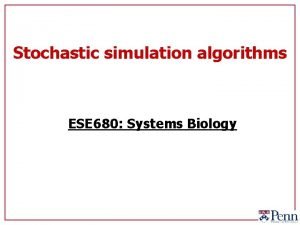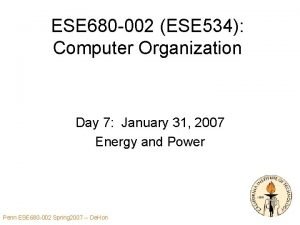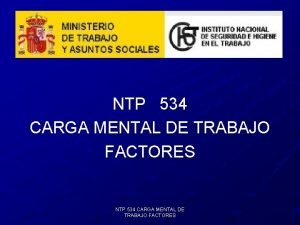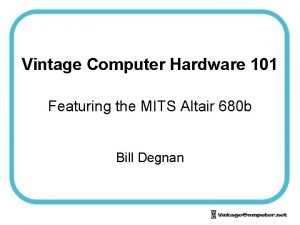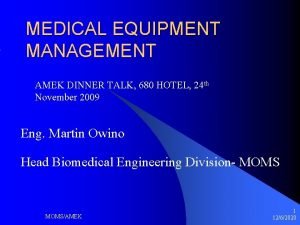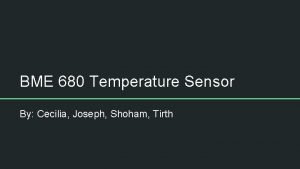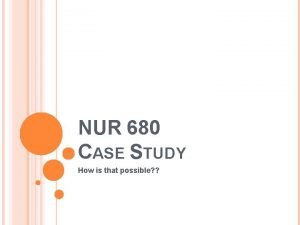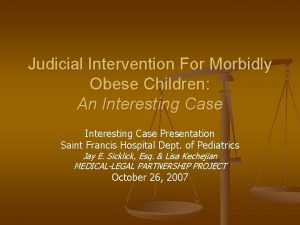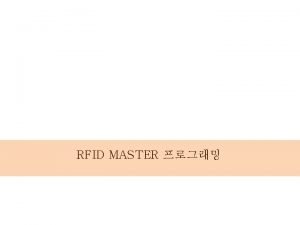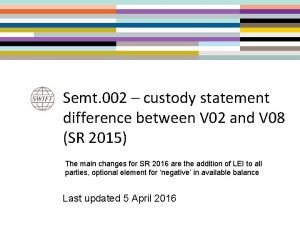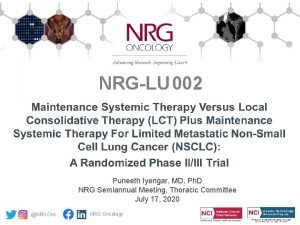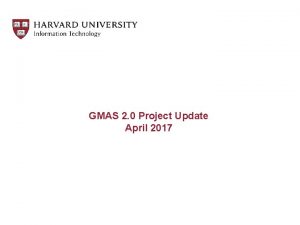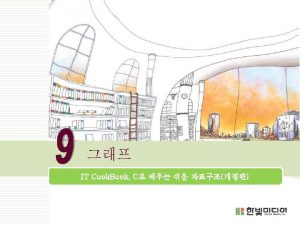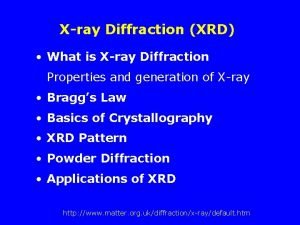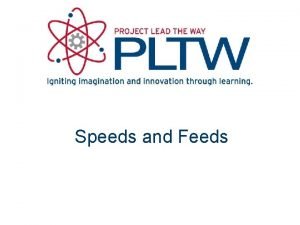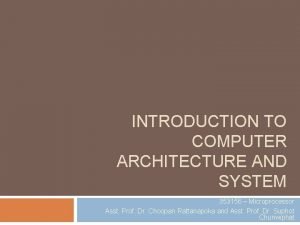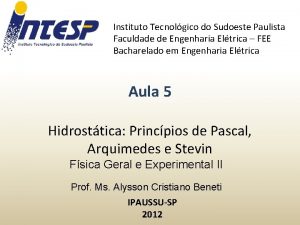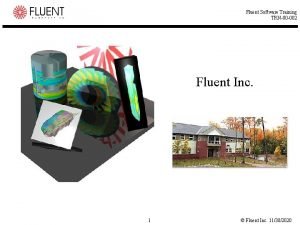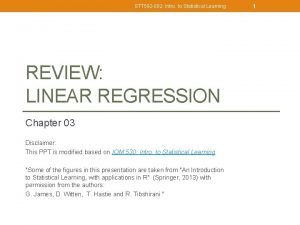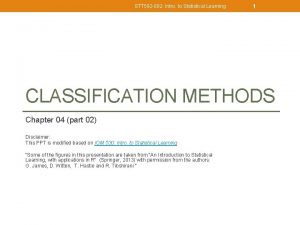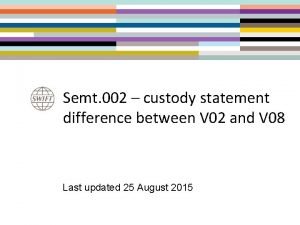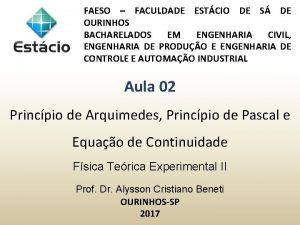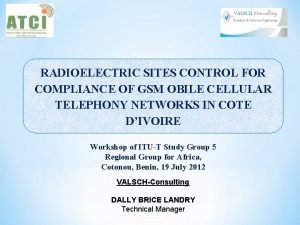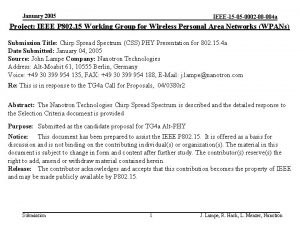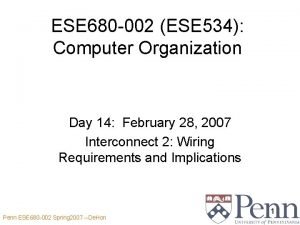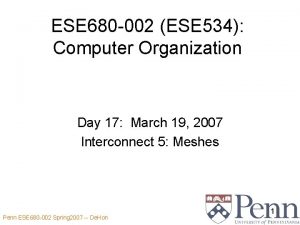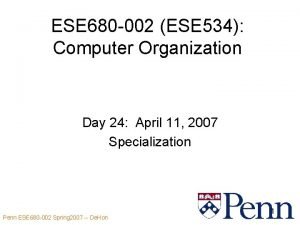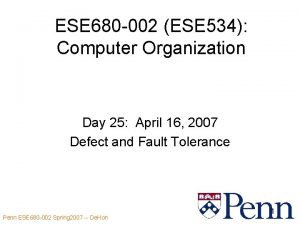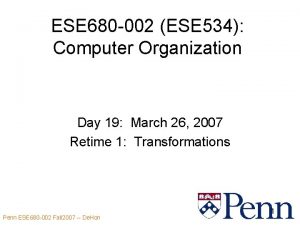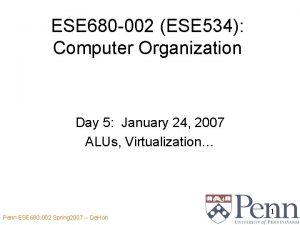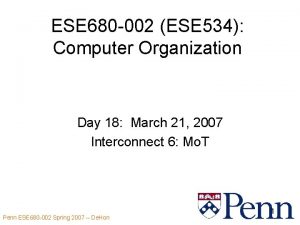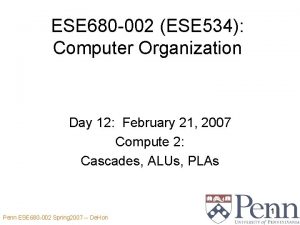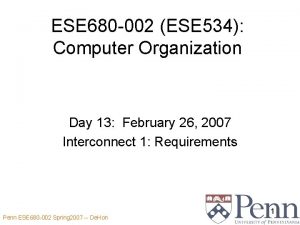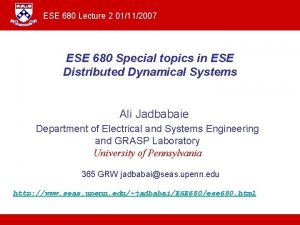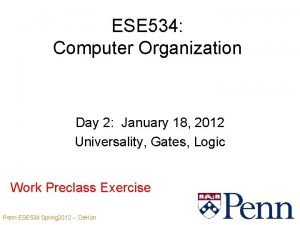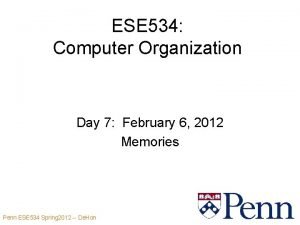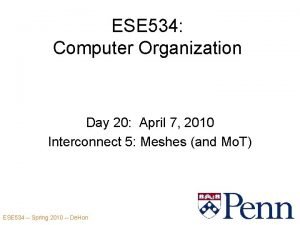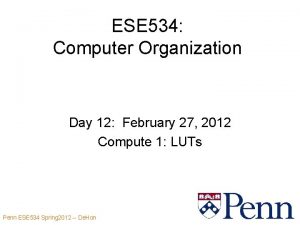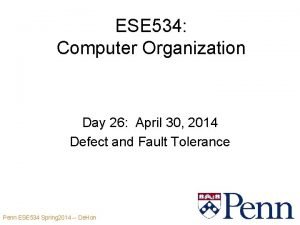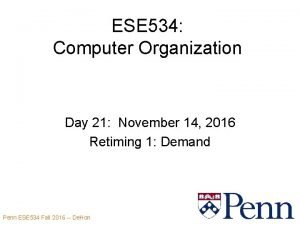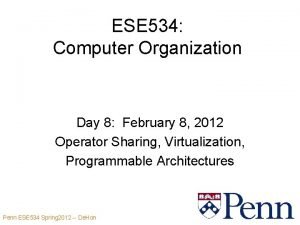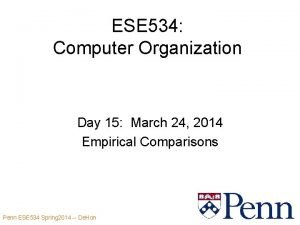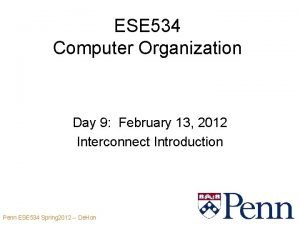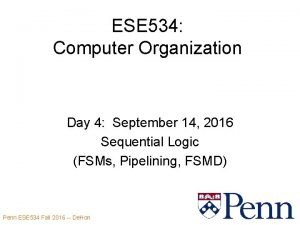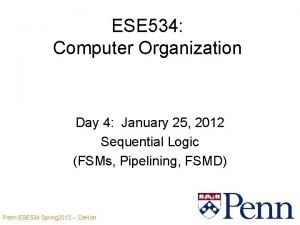ESE 680 002 ESE 534 Computer Organization Day









































![Big Ideas [MSB Ideas] • Several cases cannot profitably reuse same logic at device Big Ideas [MSB Ideas] • Several cases cannot profitably reuse same logic at device](https://slidetodoc.com/presentation_image_h2/8589a035dd0c61405131c1597b44c665/image-42.jpg)
![Big Ideas [MSB-1 Ideas] • Economical retiming becomes important here to achieve active LUT Big Ideas [MSB-1 Ideas] • Economical retiming becomes important here to achieve active LUT](https://slidetodoc.com/presentation_image_h2/8589a035dd0c61405131c1597b44c665/image-43.jpg)
- Slides: 43

ESE 680 -002 (ESE 534): Computer Organization Day 21: April 2, 2007 Time Multiplexing Penn ESE 680 -002 Spring 2007 -- De. Hon 1

Previously • Saw how to pipeline architectures – specifically interconnect – talked about general case • Including how to map to them • Saw how to reuse resources at maximum rate to do the same thing Penn ESE 680 -002 Spring 2007 -- De. Hon 2

Today • Multicontext – Review why – Cost – Packing into contexts – Retiming requirements • [concepts we saw in overview week 2 -3, we can now dig deeper into details] Penn ESE 680 -002 Spring 2007 -- De. Hon 3

How often is reuse of the same operation applicable? • In what cases can we exploit highfrequency, heavily pipelined operation? • …and when can we not? Penn ESE 680 -002 Spring 2007 -- De. Hon 4

How often is reuse of the same operation applicable? • Can we exploit higher frequency offered? – High throughput, feed-forward (acyclic) – Cycles in flowgraph • abundant data level parallelism [C-slow] • no data level parallelism – Low throughput tasks • structured (e. g. datapaths) [serialize datapath] • unstructured – Data dependent operations • similar ops [local control -- next time] • dis-similar ops Penn ESE 680 -002 Spring 2007 -- De. Hon 5

Structured Datapaths • Datapaths: same pinst for all bits • Can serialize and reuse the same data elements in succeeding cycles • example: adder Penn ESE 680 -002 Spring 2007 -- De. Hon 6

Throughput Yield FPGA Model -- if throughput requirement is reduced for wide word operations, serialization allows us to reuse active area for same computation Penn ESE 680 -002 Spring 2007 -- De. Hon 7

Throughput Yield Same graph, rotated to show backside. Penn ESE 680 -002 Spring 2007 -- De. Hon 8

Remaining Cases • Benefit from multicontext as well as high clock rate • i. e. – cycles, no parallelism – data dependent, dissimilar operations – low throughput, irregular (can’t afford swap? ) Penn ESE 680 -002 Spring 2007 -- De. Hon 9

Single Context • When have: – cycles and no data parallelism – low throughput, unstructured tasks – dis-similar data dependent tasks • Active resources sit idle most of the time – Waste of resources • Cannot reuse resources to perform different function, only same Penn ESE 680 -002 Spring 2007 -- De. Hon 10

Resource Reuse • To use resources in these cases – must direct to do different things. • Must be able tell resources how to behave • separate instructions (pinsts) for each behavior Penn ESE 680 -002 Spring 2007 -- De. Hon 11

Example: Serial Evaluation Penn ESE 680 -002 Spring 2007 -- De. Hon 12

Example: Dis-similar Operations Penn ESE 680 -002 Spring 2007 -- De. Hon 13

Multicontext Organization/Area • Actxt 80 Kl 2 • Actxt : Abase = 1: 10 – dense encoding • Abase 800 Kl 2 Penn ESE 680 -002 Spring 2007 -- De. Hon 14

Example: DPGA Prototype Penn ESE 680 -002 Spring 2007 -- De. Hon 15

Example: DPGA Area Penn ESE 680 -002 Spring 2007 -- De. Hon 16

Multicontext Tradeoff Curves • Assume Ideal packing: Nactive=Ntotal/L Reminder: Robust point: c*Actxt=Abase Penn ESE 680 -002 Spring 2007 -- De. Hon 17

In Practice Limitations from: • Scheduling • Retiming Penn ESE 680 -002 Spring 2007 -- De. Hon 18

Scheduling Limitations • NA (active) – size of largest stage • Precedence: can evaluate a LUT only after predecessors have been evaluated cannot always, completely equalize stage requirements Penn ESE 680 -002 Spring 2007 -- De. Hon 19

Scheduling • Precedence limits packing freedom • Freedom do have – shows up as slack in network Penn ESE 680 -002 Spring 2007 -- De. Hon 20

Scheduling • Computing Slack: – ASAP (As Soon As Possible) Schedule • propagate depth forward from primary inputs – depth = 1 + max input depth – ALAP (As Late As Possible) Schedule • propagate distance from outputs back from outputs – level = 1 + max output consumption level – Slack • slack = L+1 -(depth+level) [PI depth=0, PO level=0] Penn ESE 680 -002 Spring 2007 -- De. Hon 21

Slack Example Penn ESE 680 -002 Spring 2007 -- De. Hon 22

Allowable Schedules Active LUTs (NA) = 3 Penn ESE 680 -002 Spring 2007 -- De. Hon 23

Sequentialization • Adding time slots – more sequential (more latency) – add slack • allows better balance L=4 NA=2 (4 or 3 contexts) Penn ESE 680 -002 Spring 2007 -- De. Hon 24

Multicontext Scheduling • “Retiming” for multicontext – goal: minimize peak resource requirements • resources: logic blocks, retiming inputs, interconnect • NP-complete • list schedule, anneal Penn ESE 680 -002 Spring 2007 -- De. Hon 25

Multicontext Data Retiming • How do we accommodate intermediate data? • Effects? Penn ESE 680 -002 Spring 2007 -- De. Hon 26

Signal Retiming • Non-pipelined – hold value on LUT Output (wire) • from production through consumption – Wastes wire and switches by occupying • for entire critical path delay L • not just for 1/L’th of cycle takes to cross wire segment – How show up in multicontext? Penn ESE 680 -002 Spring 2007 -- De. Hon 27

Signal Retiming • Multicontext equivalent – need LUT to hold value for each intermediate context Penn ESE 680 -002 Spring 2007 -- De. Hon 28

DES Latency Example Single Output case Penn ESE 680 -002 Spring 2007 -- De. Hon 29

Alternate Retiming • Recall from last time (Day 20) – Net buffer • smaller than LUT – Output retiming • may have to route multiple times – Input buffer chain • only need LUT every depth cycles Penn ESE 680 -002 Spring 2007 -- De. Hon 30

Input Buffer Retiming • Can only take K unique inputs per cycle • Configuration depth differ from contextto-context Penn ESE 680 -002 Spring 2007 -- De. Hon 31

ASCII Hex Example Single Context: 21 LUTs @ 880 Kl 2=18. 5 Ml 2 Penn ESE 680 -002 Spring 2007 -- De. Hon 32

ASCII Hex Example Three Contexts: 12 LUTs @ 1040 Kl 2=12. 5 Ml 2 Penn ESE 680 -002 Spring 2007 -- De. Hon 33

ASCII Hex Example • All retiming on wires (active outputs) – saturation based on inputs to largest stage Ideal Perfect scheduling spread + no retime overhead Penn ESE 680 -002 Spring 2007 -- De. Hon 34

ASCII Hex Example (input retime) @ depth=4, c=6: 5. 5 Ml 2 (compare 18. 5 Ml 2 ) Penn ESE 680 -002 Spring 2007 -- De. Hon 35

General throughput mapping: • If only want to achieve limited throughput • Target produce new result every t cycles 1. Spatially pipeline every t stages cycle = t 2. retime to minimize register requirements 3. multicontext evaluation w/in a spatial stage retime (list schedule) to minimize resource usage 4. Map for depth (i) and contexts (c) Penn ESE 680 -002 Spring 2007 -- De. Hon 36

Benchmark Set • 23 MCNC circuits – area mapped with SIS and Chortle Penn ESE 680 -002 Spring 2007 -- De. Hon 37

Multicontext vs. Throughput Penn ESE 680 -002 Spring 2007 -- De. Hon 38

Multicontext vs. Throughput Penn ESE 680 -002 Spring 2007 -- De. Hon 39

General Theme • Ideal Benefit – e. g. Active=N/C • Precedence Constraints • Resource Limits – Sometimes bottleneck • Net Benefit • Resource Balance Penn ESE 680 -002 Spring 2007 -- De. Hon 40

Admin • Assignment 8 due Wednesday • Still swapping around lectures – Note reading for Wed. online • Final Exercise out Wednesday – …on everything… – …but includes time multiplexing Penn ESE 680 -002 Spring 2007 -- De. Hon 41
![Big Ideas MSB Ideas Several cases cannot profitably reuse same logic at device Big Ideas [MSB Ideas] • Several cases cannot profitably reuse same logic at device](https://slidetodoc.com/presentation_image_h2/8589a035dd0c61405131c1597b44c665/image-42.jpg)
Big Ideas [MSB Ideas] • Several cases cannot profitably reuse same logic at device cycle rate – cycles, no data parallelism – low throughput, unstructured – dis-similar data dependent computations • These cases benefit from more than one instructions/operations per active element • Actxt<< Aactive makes interesting – save area by sharing active among instructions Penn ESE 680 -002 Spring 2007 -- De. Hon 42
![Big Ideas MSB1 Ideas Economical retiming becomes important here to achieve active LUT Big Ideas [MSB-1 Ideas] • Economical retiming becomes important here to achieve active LUT](https://slidetodoc.com/presentation_image_h2/8589a035dd0c61405131c1597b44c665/image-43.jpg)
Big Ideas [MSB-1 Ideas] • Economical retiming becomes important here to achieve active LUT reduction – one output reg/LUT leads to early saturation • c=4 --8, I=4 --6 automatically mapped designs 1/2 to 1/3 single context size • Most FPGAs typically run in realm where multicontext is smaller – How many for intrinsic reasons? – How many for lack of HSRA-like register/CAD support? Penn ESE 680 -002 Spring 2007 -- De. Hon 43
 Ese 680
Ese 680 Ese 680
Ese 680 Ese 680
Ese 680 Day 1 day 2 day 3 day 4
Day 1 day 2 day 3 day 4 Ntp 534
Ntp 534 Day 1 day 2 day 817
Day 1 day 2 day 817 Process organization in computer organization
Process organization in computer organization Mits altair 680
Mits altair 680 Talk 680
Talk 680 F tag 680
F tag 680 Bme 680
Bme 680 Nur 680
Nur 680 Morbidly interesting
Morbidly interesting 420 in word form
420 in word form A 680 newton student runs up a flight of stairs
A 680 newton student runs up a flight of stairs Basic structure of computer in computer organization
Basic structure of computer in computer organization Diff between computer organization and architecture
Diff between computer organization and architecture Design of basic computer
Design of basic computer Interrupt cycle flow chart
Interrupt cycle flow chart C++ mfc 예제
C++ mfc 예제 Norsok z-dp-002
Norsok z-dp-002 Semt.001
Semt.001 Puneeth iyengar
Puneeth iyengar Cip 002-009
Cip 002-009 Gmas-002
Gmas-002 Site structure
Site structure 001 002 003
001 002 003 002
002 What is cutting speed in milling
What is cutting speed in milling 002
002 353156
353156 Pressão hidrostática
Pressão hidrostática 002
002 Flowchart elevator
Flowchart elevator Um objeto com massa de 10kg e volume de 0 002
Um objeto com massa de 10kg e volume de 0 002 002
002 Faculty marshall usc advertising csv
Faculty marshall usc advertising csv 002
002 Semt.002
Semt.002 Fibrous capsule
Fibrous capsule Um objeto com massa de 10kg e volume de 0 002
Um objeto com massa de 10kg e volume de 0 002 Dtu p 06-002
Dtu p 06-002 0,05/0,002
0,05/0,002 001 002 003
001 002 003
